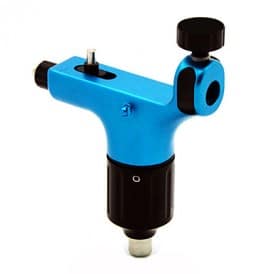Rotary tattoo machines are becoming more and more popular in the industry these past couple of years. With popularity comes diversity and today, there are many different types of rotary tattoo machines available. The main types are the Direct Drive, Armature Bar Guided, Linear Action and Swashdrive. These 4 main types seem to form the core from which rotaries are developed. Modifications to to these main designs results in various hybrids like the popular Dragonfly. In this article, we will explain the properties of these 4 main types.
Direct Drive Rotary Tattoo Machine
Cam Wheel or bearing is directly placed on motor shaft and needle attaches directly to the cam wheel. The circular motion of the wheel with the needle bar attached makes the needle bar cycle up and down. An example of direct drive rotaries that we produce are the Hildbrandt Executioner, Assassin, Marksman and Sniper.
Pros: Extremely quiet, most efficient use of movement from motor.
Cons: Can be difficult to stabilize needle. Less range of adjustment for depth.
Armature Bar Rotary Tattoo Machine
A small cam Wheel is attached to an arm that links to an armature bar. The circular motion of the cam wheel pushes the armature bar in an up and down motion. The needle bar is attached to the armature bar. Examples of armature bar rotary tattoo machines we produce are the Hildbrandt Beretta, Silencer and Inkstar Hitman.
Pros: Needle bar up and down motion is very accurate since it is guided by the armature bar which is held in place by the frame of the machine. Needle bar will remain stable in just about any configuration. Simple to adjust throw of machine, increase length of cam arm for a slower shader or decrease length for a faster liner.
Cons: Loud, considering one of the highlights of a rotary machine is its quiet function, the armature bar rotary tattoo machine would be the loudest type of rotary. It will still be quieter than most coil machines.

Linear Action Rotary Tattoo Machine
The needle bar attaches to a slider mechanism that is held in place by a channel. The motor is usually hidden under an enclosed frame and the shaft is attached to the slider mechanism. An example of a linear action we make is the Inkstar Zipliner (available after March 2013).
Pros: Fairly quiet and smooth if the channel and slider mechanism is assembled together well. Will be just as stable as an Armature bar rotary. If the machine has a built in adjustment mechanism on the slider, a large degree of adjustment is possible.
Cons: Friction between slider and frame chassis may increase chance of machine heating up. Usually difficult to take apart and fix.

Swashdrive Rotary Tattoo Machine
Uses a swash plate to convert the rotation of the motor into an up and down motion. These are really fun to watch in motion. Examples of swashdrive rotaries we make are the Inkstar Hammer and Screwdriver (both available after March 2013).
Pros: Very quiet and smooth. Hybrid versions allow for a wide range of adjustments.
Cons: Running at higher voltages may cause instability if poorly assembled or swash plate/motor mechanisms are not well lubricated.

